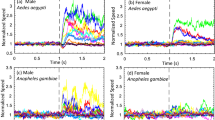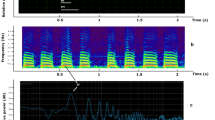Abstract
We experimentally demonstrated that tonal acoustic signals with a carrier frequency of 140–200 Hz had a repellent effect on male mosquitoes (Culicidae). Swarming males of Aedes diantaeus were concentrated in a small space near the auxiliary attracting sound source which simulated the flight sound of conspecific females (carrier frequency 280–320 Hz). Then, the resulting cluster of attracted mosquitoes was stimulated with test signals of variable amplitude and carrier frequency from a second loudspeaker. The direction of mosquito flight from the source of test sounds and a decrease in their number above the attracting sound source were used as the criteria of behavioral response. Pronounced avoidance responses (negative phonotaxis) of swarming mosquitoes were observed in the range of 140–200 Hz. Most of the mosquitoes left the area above the attracting sound source within one second after the onset of the test signal. Mosquitoes mostly flew up, sideways, and backwards in relation to the test acoustic vector. We presume that mosquitoes develop defensive behavior against attacking predatory insects based on analysis of auditory information. The range of negative phonotaxis is limited at higher frequencies by the spectrum of the flight sounds of conspecific females, and in the low frequency range, by the increasing level of atmospheric noise.
Similar content being viewed by others
References
Adaev, M.B., Grinchenko, V.D., Gruzdev, G.A., and Lapshin, D.N., “The Responses of Swarming Midges Cladotanytarsus (Chironomidae, Diptera) to Acoustic Stimuli,” Byulleten Moskovskogo Obshchestva Ispytatelei Prirody 121 (5), 26–32 (2016).
Apasov, S.G., Zhantiev, R.D., Tamarina, N.A., and Fedorova, M.V., “Acoustic Orientation of Male Mosquitoes Aedes diantaeus during Mating,” Parazitologiya 20 (5), 351–355 (1986).
Boo, K.S. and Richards, A.G., “Fine Structure of the Scolopidia in the Johnston’s Organ of Male Aedes aegypti (L.) (Diptera: Culicidae),” International Journal of Insect Morphology and Embryology 4, 549–566 (1975).
Cator, L.J., Arthur, B.J., Harrington, L.C., and Hoy, R.R., “Harmonic Convergence in the Love Songs of the Dengue Vector Mosquito,” Science 323, 1077–1079 (2009).
Charlwood, J.D. and Jones, M.D.R., “Mating Behaviour in the Mosquito, Anopheles gambiae s. l. I. Close Range and Contact Behaviour,” Physiological Entomology 4, 111–120 (1979).
Downes, J.A., “Feeding and Mating in the Insectivorous Ceratopogoninae (Diptera),” Memoirs of the Entomological Society of Canada 110 (S104), 1–62 (1978).
Ikeshoji, T., “Distribution of the Mosquitoes, Culex tritaeniorhynchus in Relation to Disposition of Sound Traps in a Paddy Field,” Japanese Journal of Sanitary Zoology 37, 153–159 (1986).
Kazhan, V.G., Moshkov, P.A., and Samokhin, V.F., “Background Noise during Acoustic Trials in Airfields Servicing Small Aircraft,” Nauka i Obrazovanie 7, 146–170 (2015).
Lakin, G.F., Biometrics (Vysshaya Shkola, Moscow, 1990) [in Russian].
Lapshin, D.N., “Frequency Characteristics of the Auditory Interneurons of Male Culex pipiens pipiens L. (Diptera, Culicidae),” Doklady Akademii Nauk 439 (2), 279–282 (2011).
Lapshin, D.N., “Frequency Characteristics of the Auditory Receptors of Non-Biting Midges (Diptera, Chironomidae),” Sensornye Sistemy 27 (1), 35–46 (2013).
Lapshin, D.N., “Directional and Frequency Characteristics of Auditory Receptors in Midges (Diptera, Chironomidae),” Entomologicheskoe Obozrenie 94 (4), 761–776 (2015) [Entomological Review 95 (9), 1155–1165 (2015)].
Lapshin, D.N. and Vorontsov, D.D., “Frequency Organization of the Johnston Organ in Male Mosquitoes (Diptera, Culicidae),” Journal of Experimental Biology 220, 3927–3938 (2017).
Roth, L.M., “A Study of Mosquito Behavior: an Experimental Laboratory Study of the Sexual Behavior of Aedes aegypti (Linnaeus),” American Midland Naturalist 40, 265–352 (1948).
Schindelin, J., Arganda-Carreras, I., Frise, E., Kaynig, V., Longair, M., Pietzsch, T., Preibisch, S., Rueden, C., Saalfeld, S., Schmid, B., Tinevez, J.Y., White, D.J., Hartenstein, V., Eliceiri, K., Tomancak, P., and Cardona, A., “Fiji: an Open-Source Platform for Biological-Image Analysis,” Nature Methods 9 (7), 676–682 (2012).
Simões, P.M.V., Ingham, R.A., Gibson, G., and Russell, I.J., “A Role for Acoustic Distortion in Novel Rapid Frequency Modulation Behaviour in Free-Flying Male Mosquitoes,” Journal of Experimental Biology 219, 2039–2047 (2016).
Simões, P.M., Gibson, G., and Russell, I.J., “Pre-Copula Acoustic Behaviour of Males in the Malarial Mosquitoes Anopheles coluzzii and Anopheles gambiae s. s. does not Contribute to Reproductive Isolation,” Journal of Experimental Biology 220, 379–385 (2017).
Smith, S.M. and Gadawski, R.M., “Nectar Feeding by the Early-Spring Mosquito Aedes provocans,” Medical and Veterinary Entomology 8 (3), 201–213 (1994).
Tamarina, N.A. and Aleksandrova, K.V., “Observations of Aedes diantaeus in the Nature and Experience of Its Laboratory Culturing,” Meditsinskaya Parazitologiya 1, 19–23 (1977).
Van Handel, E., “Metabolism of Nutrients in the Adult Mosquito,” Mosquito News 44, 573–579 (1984).
Wishart, G. and Riordan, D.F., “Flight Responses to Various Sounds by Adult Males of Aedes aegypti (L.) (Diptera: Culicidae),” The Canadian Entomologist 91, 181–191 (1959).
Author information
Authors and Affiliations
Corresponding author
Additional information
Original Russian Text © D.N. Lapshin, D.D. Vorontsov, 2018, published in Entomologicheskoe Obozrenie, 2018, Vol. 97, No. 2, pp. 194–202.
Rights and permissions
About this article
Cite this article
Lapshin, D.N., Vorontsov, D.D. Low-Frequency Sounds Repel Male Mosquitoes Aedes diantaeus N.D.K. (Diptera, Culicidae). Entmol. Rev. 98, 266–271 (2018). https://doi.org/10.1134/S0013873818030028
Received:
Published:
Issue Date:
DOI: https://doi.org/10.1134/S0013873818030028




